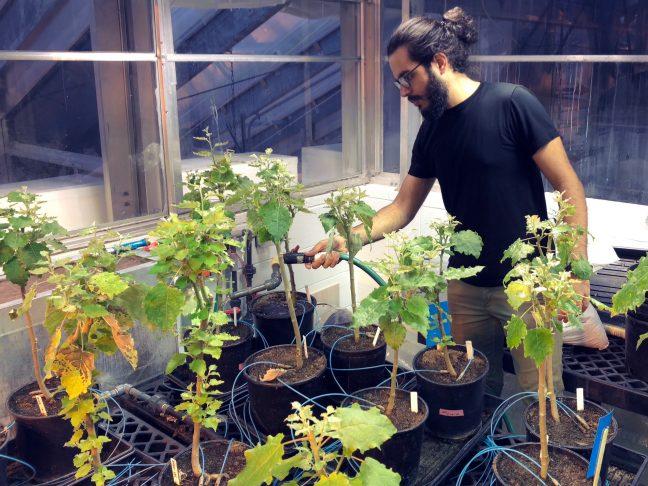The University of Wisconsin Herbarium is home to the largest collection of plants in all of Wisconsin. This museum on campus mounts, dries and studies native plants of Wisconsin, as well as rare species from across the world, according to former senior academic curator Ted Cochrane.
Though this is an impressive feat in and of itself, the vast collection serves a great purpose for UW. Specifically, Cochrane said there are four main reasons for this collection — it serves as a reference collection to check the IDs of plants, a teaching aid, a historical lesson and is a bursting research center.
“Any large herbarium is the basis for at least some of the botanical literature,” Cochrane said. “One of the greatest functions of an herbarium is to serve as a record of the plants that are described in books and papers.”
The herbarium is a poster child for life that has been on Earth, Cochrane said. This hidden gem on campus has many interesting facts surrounding it.
Holding over 1.37 million species, the Herbarium is a notable source of information, Cochrane said. It is an informative spot to see how flora landscapes have changed over time in Madison — and the whole state of Wisconsin — and documents the plants that make up the vegetation of a world under constant attack from environmental threats. The Herbarium is the perfect place on campus to see how the environment — specifically plants — has changed with the adapting climate.
“Mostly [the Herbarium] documents plants that make up the vegetation of the world which is continuously under assault,” Cochrane said.
Cochrane said the museum can be used to teach more optimistic lessons to younger children and often has tours of commonly profitable plants, such as cotton and coffee beans.
The museum works nationally and internationally. During his time at the Herbarium, Cochrane traveled to Mexico in collaboration with the University of Guadalajara, in which they studied rare types of perennial, non-annual maize, Cochrane said. This was a revolutionary discovery of a new plant type, in which UW was involved early on.
Having such an extensive collection of specimens, however, requires keeping careful records. This process begins with pressing the plants carefully, making sure they are dry — to prevent water damage — and well-sealed. Then, the specimen is placed next to a ruler to clearly show the size and is paired with handwritten and typed annotation labels. Finally, it is stamped with a numeric and specimen label. This process, though tedious, ensures the species are correctly identified. When a plant matches none of the existing identifications, it is given its own.
Another botany-centered spot on campus, which focuses on teaching and offering hands-on horticulture experience, is the Allen Centennial Garden.
Allen Centennial Garden Director Reba Luiken said the garden is a “live laboratory,” where students and public groups can visit and learn about the various kitchen and traditional gardens.
Luiken said the Garden is currently working with horticulture and religious studies classes, studying plant identification with their herb and kitchen gardens.
There are three main kitchen gardens — a West African, a Hmong and a Native American garden, which is called the Three Sisters Garden. The Three Sisters Garden focuses on planting corn, squash and beans together — a Native American tradition that helps the plants thrive off of each other.
Religious studies classes recently visited the Allen Centennial Gardens to learn about how all three kitchen gardens’ ingredients relate to the religious groups they studied during their courses and discussed the intersection of food and religion, Luiken said.
The Garden also works with the School of Pharmacy by studying tobacco, poppy seeds used for opioids and absinthe related plants in the Garden, Luiken said.
The Department of Horticulture is currently holding research in Allen Centennial Garden under the direction of assistant professor Al Kovaleski. The research is centered around cold heartedness and dormancy of plants, Luiken said, meaning how plants react to the cold and their inability to germinate even under ideal conditions.
After the Harvest Festival, a day-long event the Allen Centennial Gardens hosted Oct. 8, Luiken said most of its plants will have been harvested and donated to several groups, including local food shelves. Remaining plants can also be used for research, Luiken said.
Luiken said in the past, the Garden partnered with two local farmers in West Madison to teach the public about honey bees and why they make their honeycombs in hexagons — it involves building fewer walls.
In the future, the Garden hopes to reach out and teach in local libraries about the findings of its research like it did in the past with a program about honeybees.
Both the Herbarium and the Allen Centennial Gardens have more to do inside than what meets the eye — the trickiest part is gaining access.
Located on the first floor of Birge Hall, the Herbarium is open for visitation from 7:45 a.m. to 4:30 p.m. Volunteers offer personal or group tours, which last around 30-50 minutes according to the website.
As for the Allen Centennial Gardens, it is open to students and the public from dusk to dawn, and there are always open tables and chairs for studying.


